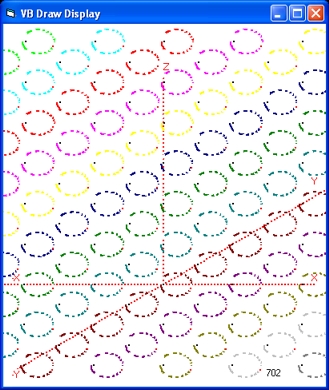 Display 5
Display 5
|
Display 5 shows an image of the 3D universe with Black Holes at equally spaced distances.
Each BH is accompanied with one star or mini BH
To observe the 3D world it is important to imagine that each Black Hole is observed many times in different parallel planes.
- The first plane is the X,0,Z plane. The origin of this plane is the point (0,0,0)
- The second plane is the X,1,Z plane. The origin of this plane is the point (0,1,0). This is a point in the direction of the point (0,0,0) at 2 o'clock. These seem the same black holes as the black holes in the first plane but they are not.
- The third plane is the X,2,Z plane. The origin of this plane is the point (0,2,0).
- In total there are 9 planes along the Y axis, starting from the point (0,-4,0) and finishing at the point (0,4,0)
All these planes are parallel to the X and Z axis.
We can also study planes parallel to the Y and Z axis.
- The first plane is the 0,Y,Z plane. The origin of this plane is the point (0,0,0)
- The second plane is the 1,Y,Z plane. The origin of this plane is the point (1,0,0). This is a point in the direction of the point (0,0,0) at 3 o'clock. These seem the same black holes as the black holes in the first plane but they are not.
- The third plane is the 2,Y,Z plane. The origin of this plane is the point (2,0,0).
- More planes can be identified i.e. through the points -1,Y,Z and -2,Y,Z
We can also study planes parallel to X and Y axis. These are all horizontal.
|
 Display 6
Display 6
|
Display 5 shows an image of the 3D universe with Black Holes at equally spaced distances throughout the total universe of which only a 'small' part is visible. Each BH is accompanied with a revolving star. The star is simulated using Newton's Law as a simple binary system. One revolution requires roughly the calculation of 775 positions.
In Display 5 all these positions are shown, which give the impression of a continuous line.
Display 6 shows the same simulation and each revolution requires also 775 calculations but not all the positions are visible. In fact only 50% are shown in a distinctive colour. All the others are shown in white.
What is important the positions are shown in groups. Group #1 of 25 positions is shown in red. Group #2 of 25 points in white. Group #3 in red and the same with the groups 5,7,9,11 until group 31. This completes one revolution. (31*25=775). The next revolution starts a white group and now all the even groups are in red. The result is that you can follow where the star is. What is more important you can follow the evolution of each star instantaneous throughout the total universe.
To get an idea of how this works, please select Display 6. When selected the display switches instantaneous to a different world view i.e. from calculation 702 into 2000. In fact you get an instantaneous view of the state of the total universe independent of the observer. This is an important concept, which requires a deeper investigation. An observer observes with his eyes and what he or she observes is in the past. In Display 5 and 6 this time delay is not included. Both displays show no horizon.
- One virtual experiment you can perform is to connect a clock to each black hole a clock and observe that all clocks show the same count.
- You can also connect a clock to each star and observe that all these moving clocks show less counts than the Black Holes.
|







